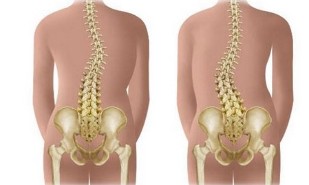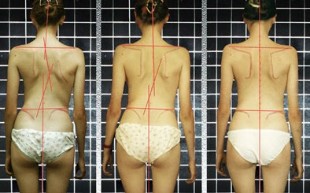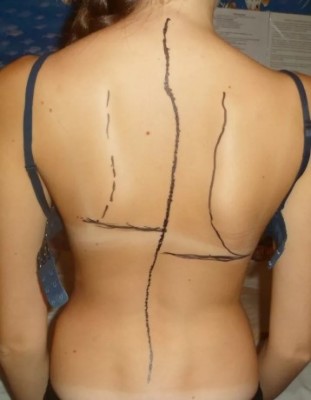In the Greek there is the word "scolios", which translates as "the curve". This word the doctors indicate the curvature of the spine. Also, not every curvature, i.e. the deviation to the side of the vertical axis of the spine. The fact is that, normally, our spine is not perfectly smooth. Are available in the foreground and the background in the direction of the curves (lordosis and kyphosis) protect our spine from excessive loads while keeping the body in a particular position when you are travelling and carrying heavy loads. Negative processes in our body develop only in those cases, if these kyphosis and lordosis expressed above the legal limit.

The main problems
However, even a small degree of lateral curves (scoliosis) of the spine is always a malocclusion. And this is not only a cosmetic defect. Even if the characteristic repulsive aspect with the express or progression of scoliosis is always a tragedy for a man who tries to live the quality of life hangs in the balance. This is especially true for young boys and girls. Because it is in childhood and youth of the period (up to 15 – 16 years old) is diagnosed with a significant scoliosis.
The main problem lies in the fact that, due to changes of configuration and the volume of the thorax when expressed side distortions still suffer from the internal organs (heart, lungs, stomach, liver, intestines, blood vessels). The men of reduced exercise tolerance in women you are experiencing problems with conception, bearing pregnancy, and infertility. Also, very often the lateral deformation of the spinal column – is only the tip of the iceberg, which is a symptom much more serious malocclusion – cancer, tuberculosis, endocrine disorders.
Causes
So why, then, deform the spine? Before answering the question, it is worthwhile to determine the types of scoliosis. Intrinsically scoliosis can be structural and non-structural. Structural scoliosis can develop because of changes in the anatomical structure of the bone of the vertebrae, and also in the vicinity of the muscles, nerves, ligaments of the device. Such curvature can be acquired and congenital, and the share of the latter represent about a quarter of all diagnosed scoliosis.
One of the main causes of the development of structural scoliosis are:

- Defects of fetal development, which can lead to dysplastic violations of one or more vertebrae
- Congenital anomalies of the chest – absence of edges, the ribs
- A congenital disorder of the connective tissue – neurofibromatosis, Marfan syndrome
- Cerebrovascular insufficiency due to cerebral palsy (CP), leads to the rupture innervation in certain areas of the spine
- Osteoporosis (depression of the bone) of the vertebral column during rickets, diseases of the parathyroid glands, the lack of arrivals of calcium with the food
- Osteomyelitis spine
- Dystrophic changes of the cervical spine, the thoracic and the lumbar musculature
- Tuberculosis damages the vertebral
- Injuries to the spine
- Tumors of the spinal column.
Development of scoliosis as the name suggests – is the lateral deviation of the axis of the spine to the unchanged structure of the vertebrae. Usually, these scoliosis most often purchased with the exception of those cases in which the curvature leads to compensation of character when anatomical congenital defects of the pelvis or lower limbs. The causes of these scoliosis most often are:
- Trauma of the pelvis and lower limbs
- Congenital defects of the pelvis and lower limbs
- Constant incorrect posture in children
- Diseases of the internal organs with asymmetrically pronounced by the pain syndrome
- Inflammation of muscles (myositis)
- Burns, scarring of the soft tissues with any thing.
In these cases, to correct the curvature of the spine is enough to treat the underlying disease, and the development of scoliosis are easily reversible. In this regard, some doctors tend not to classify development of deformation in scoliosis in general.

The recent increase in cases of development in the young people of a scoliosis with unexplained reasons. This is the so-called idiopathic scoliosis. Occurs is in his teenage years, a period of rapid growth of the body. And girls suffering from adolescent idiopathic scoliosis in a couple of times, of young people. Apparently, this is due to the relatively weak muscles of the back the female sex, which is not able to conclude the spinal column in a real muscle structure. An important role in the development of idiopathic scoliosis plays an unbalanced diet with a low content of calcium salts, mania of young people carbonated drinks. As is well known, the carbon dioxide in bubbles and orthophosphoric acid of the synthetic inclusions to promote the leaching of calcium salts from the body.
The variety and the degree of
Depending on the localization of the scoliosis can be of the neck, breast, back, or mixed (the head, neck and breast, sciatica breast). Perhaps the presence of one or more arcs of the curve. In this regard, to distinguish With a form of scoliosis (1-arc), S-shape (with 2 bows), and Z-shaped (with 3 bows). Probably, the presence of 2 or 3 arches of porta compensation of character. When in the form of scoliosis, the axis of the spine is denied. Trying to compensate for this, the spine bends in the opposite direction. In this regard, scoliosis divided into compensatory and non-compensated. Not compensated for the curvature of the spine, the vertical line lowered from the 7th cervical vertebra, passes through the crease between the buttocks.
Curvature of the spine, which often lead game character. For example, within the department over the lateral curvature of the observed pathological kyphosis, or simply the hump. In these cases, talking about breastfeeding in kyphoscoliosis . In addition, when large degrees of scoliosis, in addition to the lateral displacement of vertebrae observed and torsion. In the literal translation means twist. In fact, in many of the scoliosis is the torsion of the bone tissue on the spinal vertical axis.
Depending on the size of the angle of curvature of the arc are 4 degrees of scoliosis:
- 1-degree – bending angle not exceeding 10 degrees. Asymmetry in the eye is almost not defined. Worthy of note bending, varies the level of the shoulder girdle. jpg" class="imgblock right center_mob">
- 2 degree angle of curvature varies from 11 to 25 degrees. In this part we celebrate torsion vertebrae. It is observed that is visible to the eye, asymmetry of the shoulder girdle and the pelvic. Due to pathological muscle tension is formed muscle cushion in the lumbar area with the concave side, and in the chest area – with a convex shape.
- 3 grade – curvature is 26 to 50 degrees. Visible deformation of the thorax – the retraction intercostal gap in the concavity of the curvature and protruding with a convex shape. The weakening of the abdominal, internal training hump.
- 4 degree – bending angle I exceeds 50 degrees. Expressed aesthetic defect and of all the signs. Low tolerance even of small physical size. In addition to the muscular-skeletal system are affected internal organs.
The angle can vary depending on the location of the body, while highlighting the stable and unstable scoliosis. When a scoliosis has reduced in the supine position, when it decreases the load on the spine. In stable curvature of the spine, this value remains the same.
The symptoms
Lately, orthopedists often use the term "scoliosis" disease. And indicate a complex of those negative changes that occur in the body during bending of the spine. Usually, scoliosis the disease develops in childhood and adolescence, in the period of formation of the musculoskeletal system. In this time, there is a great probability that the scoliosis will progress.
Apparently, not the last role in an increase of the bending angle play with the intervertebral discs. In the case of a displacement of the disc experiences a pressure difference on the part of the vertebral bodies. With the concave part is at a higher pressure, with the convex shape – less. In consequence of this disc is still more wear and tear on the part of the scoliosis, is created as a pathological muscle tension (muscular cushion) and twist the vertebrae – all of this leads to the appearance of hernias of the disk, and to a further increase in the angle of curvature.

Together with the spine when scoliotico illness secondary changes in the rib cage. They form the so-called rib hump – convex shape of the curvature, the intercostal spaces expand, and with concave – on the contrary, they fall in love. For scoliosis 4 degrees of deformity of the chest is so expressed, that the lower ribs on the side of the curvature in contact with the iliac crest.
Due to a serious deformation of the chest of a guided tour during respiration difficult. At the end of the body is the expression of scoliosis does not receive the necessary amount of oxygen – it develops so-called chronic hypoxia in violation of all metabolic processes in the body. The malocclusion is complicated by the fact that changes the internal volume and the shape of the cavity of the chest. Because of this impaired circulation of blood through the vessels, are affected by light, changes the shape of the heart, the evolution of chronic cardiovascular insufficiency respiratory.
Similar changes occur in the organs of the abdominal cavity, when the lumbar and lumbo-breastfeeding scoliosis. Reduced motility of the stomach and intestines resulting in insufficient enzymatic activity of the digestive glands. All of this only exacerbates the metabolic disorder. These disorders often lead to were considered habitable puberty, boys and girls. In addition, due to lumbar scoliosis secondary curved basin. This creates a problem for mothers with bearing pregnancy and fertility.
Diagnostics
The diagnosis of scoliosis, especially large degrees, usually presents no difficulties. To detect the deformation of the spinal column are often quite normal to visual inspection. Worthy of note is visible the curvature of the contours of the spine, the asymmetry of the shoulder belt, the corners of the blade, secondary frame of the pelvis and shortening of the lower limb on the side of the curvature.
In the presence of at least one of these signs is illustrated on the x-ray of the spine. On the x-ray define the configuration, the extension and the localization of the distortions. In the course of inspection and x-ray examination can determine if the scoliosis compensated and stable. Recently received the the spread of a new method of study of the spine – magnetic resonance imaging (MRI), in which the screen of the monitor, it is possible to obtain a three-dimensional image of the spinal column. With significant distortions, it is necessary to explore the functioning of the internal organs – carry out the spirometry, electrocardiography, perform an ULTRASOUND of the heart and internal organs.
Treatment
The treatment of scoliosis can be performed in a conservative manner, and promptly. Conservative techniques refer to the pharmacological treatment, massage, physiotherapy treatments, reiki. In that regard, we must consider that the definitive formation of the spine ends at 20 years, and after this age the correction of the curvature is practically impossible. For scoliosis 1-2 degree the efforts are focused on the implementation of the origin, the normal configuration of the vertebral column. When expressed scoliosis 3 – 4 degrees is unattainable, here the main thing – to stabilize the spine and prevent the progression of scoliosis.

Drugs (chondroprotectors, vitamins, regenerative medicines in the treatment of scoliosis play only a supporting role. Strengthen muscles, remove muscular cushion, and also to a large extent stabilize the spine is possible with the help of massage and manual therapy. Good effects of damage to therapeutic exercise. But here when inadequate physical intensifies the instability of the spine and progresses scoliosis. Then a series of exercises in the development phase for each patient individually, taking into account the location and severity of the curvature. With a great degree of scoliosis is contraindicated running, strength exercises, jumps, outdoor games.
A very good result gives a correction of position is created a position optimal to promote the normalization of posture. For this are used special devices, mattresses cradle in which the young patients spend a significant part of his time. The ineffectiveness of conservative measures, the progression of the curvature indicated the surgical treatment, aiming to stabilize the spine. The surgical correction is not indicated in early childhood, his spend in adulthood, when the formation of the vertebral column is almost completed.




























